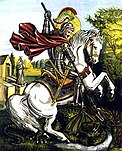A patron saint, patroness saint, patron hallow or heavenly protector is a saint who in Catholicism, Lutheranism, Anglicanism, Eastern Orthodoxy and Oriental Orthodoxy is regarded as the heavenly advocate of a nation, place, craft, activity, class, clan, family, or person.[1][2]


The term may be applied to individuals to whom similar roles are ascribed in other religions.
In Christianity
Saints often become the patrons of places where they were born or had been active. However, there were cases in medieval Europe where a city which grew to prominence and obtained for its cathedral the remains or some relics of a famous saint who had lived and was buried elsewhere, thus making them the city's patron saint – such a practice conferred considerable prestige on the city concerned. In Latin America and the Philippines, Spanish and Portuguese explorers often named a location for the saint on whose feast or commemoration day they first visited the place, with that saint naturally becoming the area's patron.[citation needed]
Occupations sometimes have a patron saint who had been connected somewhat with it, although some of the connections were tenuous. Lacking such a saint, an occupation would have a patron whose acts or miracles in some way recall the profession. For example, when the previously unknown occupation of photography appeared in the 19th century, Saint Veronica was made its patron, owing to how her veil miraculously received the imprint of Christ's face after she wiped off the blood and sweat.[3][4][5]
The veneration or "commemoration" and recognition of patron saints or saints in general is found in Catholicism (including Eastern Catholicism), Eastern Orthodoxy, Oriental Orthodoxy, and among some Lutherans and Anglicans.[6] According to the Catholic catechism a person's patron saint, having already attained the beatific vision, is able to intercede with God for their needs.[7]
Apart from Lutheranism and Anglicanism, it is, however, generally discouraged in other Protestant branches, such as Reformed Christianity, where the practice is considered a form of idolatry.[8]
Catholicism
A canonized saint can be assigned as patron by a venerable tradition, or chosen by election. The saint is considered a special intercessor with God and the proper advocate of a particular locality, occupation, etc., and merits a special form of religious observance. A term in some ways comparable is "titular", which is applicable only to a church or institution.[9]
In Islam
Although Islam has no codified doctrine of patronage on the part of saints, it has nevertheless been an important part of both Sunni and Shia Islamic traditions that particularly important classical saints have served as the heavenly advocates for specific Muslim empires, nations, cities, towns, and villages.[10] Martin Lings wrote: "There is scarcely a region in the empire of Islam which has not a Sufi for its Patron Saint."[10]: 119 As the veneration accorded saints often develops purely organically in Islamic climates, in a manner different from Catholic and Eastern Orthodox Christianity, "patron saints" are often recognized through popular acclaim rather than through official declaration.[10] Traditionally, it has been understood that the patron saint of a particular place prays for that place's wellbeing and for the health and happiness of all who live therein.[10]
However, the Wahhabi and Salafi movements have latterly attacked the veneration of saints (as patron or otherwise), which they claim are a form of idolatry or shirk.[10] More mainstream Sunni clerics have critiqued this argument since Wahhabism first emerged in the 18th century.[11] Still though, the veneration of saints in the Sunni World is as high as ever.
In Druze faith
Elijah and Jethro (Shuaib) are considered patron saints of the Druze people.[12][13] In the Old Testament, Jethro was Moses' father-in-law, a Kenite shepherd and priest of Midian.[14] Muslim scholars and the Druze identify Jethro with the prophet Shuaib, also said to come from Midian.[15] Shuaib or Jethro of Midian is considered an ancestor of the Druze who revere him as their spiritual founder and chief prophet.[16]
Druze identify Elijah as "al-Khidr".[17] Druze, like some Christians, believe that the Prophet Elijah came back as Saint John the Baptist,[17][18] since they belief in reincarnation and the transmigration of the soul, Druze believe that El Khidr and Saint John the Baptist are one and the same; along with Saint George.[18]
Due to the Christian influnce on the Druze faith, two Christian saints become the Druze's favorite venerated figures: Saint George and Saint Elijah.[19] Thus, in all the villages inhabited by Druzes and Christians in central Mount Lebanon a Christian church or Druze maqam is dedicated to either one of them.[19] According to scholar Ray Jabre Mouawad the Druzes appreciated the two saints for their bravery: Saint George because he confronted the dragon and the Prophet Elijah because he competed with the pagan priests of Baal and won over them.[19] In both cases the explanations provided by Christians is that Druzes were attracted to warrior saints that resemble their own militarized society.[19]
In Eastern religions
In Hinduism, certain sects may devote themselves to the veneration of a saint, such as the Balmiki sect that reveres Valmiki.[20]
Buddhism also includes the idea of protector deities, which are called "Dharma protectors" (Dharmapala).
See also
References
External links
- Catholic Online: Patron Saints
- Henry Parkinson (1913). . In Herbermann, Charles (ed.). Catholic Encyclopedia. New York: Robert Appleton Company.
- . Encyclopedia Americana. 1920.


